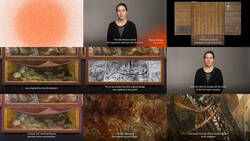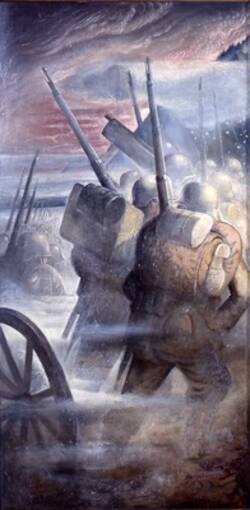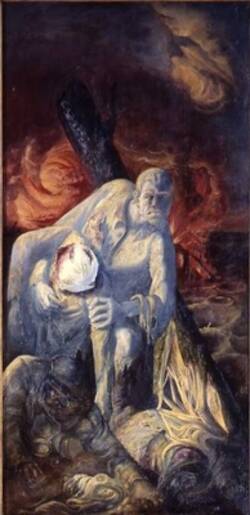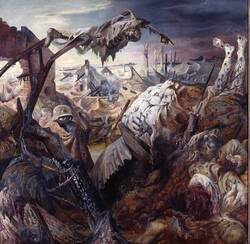In stark, unsparing detail, Otto Dix presents an eternal cycle of horror. Soldiers march off to do battle in an apocalyptic landscape; those surviving drag wounded comrades out of the line of fire. Afterwards, they retreat into the trenches, lying in dugouts reinforced with boards where they sleep like the doomed. After a few hours, they make ready to be sent over the top again, and the nightmare begins again.
In 1914, the young Otto Dix was called up and volunteered to fight on the fight line. At that time, he was 23 years old and wanted to experience the war at first hand. As curator Birgit Dalbajewa explains, the enormous power of this work lies in the objectivity of the images and their force as an eyewitness account.
“In the final analysis, Dix has created a magnificent anti-war memorial. But this neither has a wagging finger, nor couches its moral in symbolic terms. In German art history, this triptych can be regarded as ranked alongside Picasso’s ‘Guernica’, painted a few years later. But in contrast to Picasso, Dix took a quite different approach, not working with symbolism, but with seemingly realistic depictions of a situation affecting us in its own right.”
Otto Dix opted for a very traditional format – a triptych, commonly used in the late middle ages for winged altarpieces. So with its central panel and two side wings, as well as a predella – the scene along the base – the painting deliberately evokes such religious works. But here, there is no promise of salvation.
It is, though, something of a miracle that this work with its pacifist message managed to survive the Nazi regime’s iconoclast policies. Dix hid it from the Nazis, and so it could be shown at the First General German Art Exhibition in Dresden in 1946.
In 1968, it was acquired from the artist for the Dresden collections. The funds for the purchase were raised by selling numerous pieces from the Historical Museum, the Porcelain Collection and nineteenth and twentieth century works from the Galerie Neue Meister collections. So this work has a contradictory acquisition history connected with losses and gains.
Further Media
Acquisitions History
In 1933, with the help of friends, Otto Dix hid his War triptych outside Dresden. After the war, the panels were quickly recovered. In 1946, the work was a major attraction for visitors to the First General German Art Exhibition in Dresden.
Even in those early post-war years, the State Art Collections attempted to acquire the triptych. Dix was not yet prepared to sell the work, but he was willing to lend it. From 1957, his War triptych was on show in Dresden – but ten years later, Dix gave notice to the loan agreement. Then the State Art Collections made a second attempt to acquire this panel painting – and now Dix was willing to sell. But his price was painfully high for the GDR – 500,000 marks – to be paid in Deutchmarks, the West German currency. The GDR only had very limited reserves of western foreign currencies. East Germany’s Ministry of Culture declared there were no special funds available – but agreed to looking for another way to acquire this important, realistic anti-war painting. And that other way lay in selling various pieces in the Dresden Collections kept in storage. So works from the Armoury, Porcelain Collection, Historic Green Vault, and the New Masters Gallery were auctioned in the western art trade. The proceeds covered the cost of buying the triptych.
The entire process was supposed to remain secret. However, in March 1970, reports about a Sotheby’s auction appeared in the London press – a baroque rapier lavishly decorated in silver had been sold for a record price, and it came from the holdings of the Dresden Armoury! The secret was out. Newspaper articles discussed the sales and assumed – quite rightly, as it turned out – the proceeds would go to buy an outstanding work then on loan.
Even today, this is a hotly debated issue – should museums sell pieces from their holdings to obtain funds for new acquisitions?
- Location & Dating
- 1929/32
- Material & Technique
- Mixed media on wood
- Dimenions
- (4-teilig): Mitteltafel 204 x 204 cm; linker und rechter Flügel je: 204 x 102 cm; Predella: 60 x 204 cm (Katalogmaß 2010) linker Flügel: 222,2 x 117,3 x 6,3 cm; Mitteltafel: 219 x 215,9 x 8 cm; rechter Flügel: 222,5 x 117 x 6,3 cm; Predella: 75 x 123 x 6,3 cm (Rahmenmaß, Tobias Lange, 28.04.2010)
- Museum
- Galerie Neue Meister
- Inventory number
- Gal.-Nr. 3754





